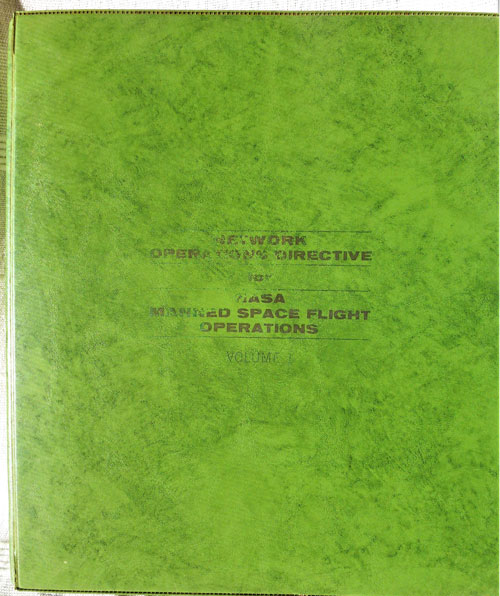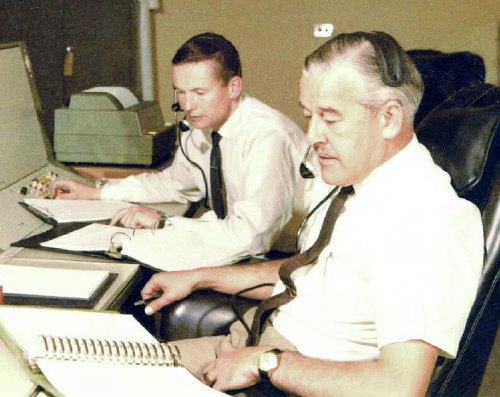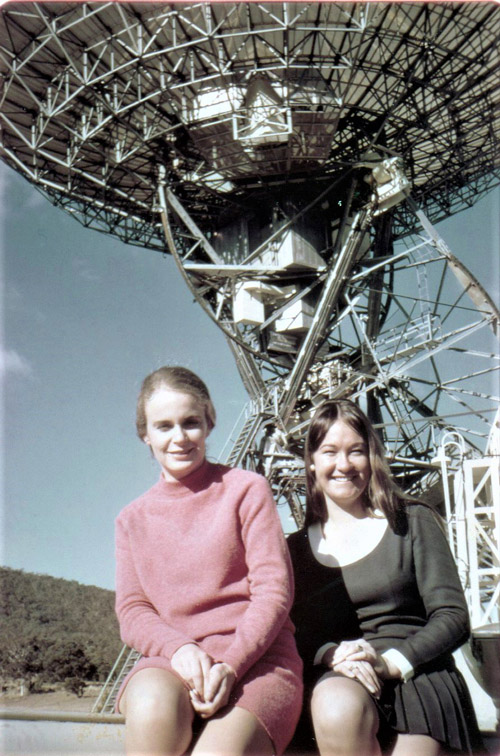Apollo 13 was launched on Sunday, 12 April, 1970 (AEST). It was my 24th Birthday. Although I did not work at the Tidbinbilla Deep Space Tracking Station in Canberra, Australia, on the weekends, my mind was on the excitement of the launch.
There had been a great deal of preparation before this Mission, with simulations, scenarios and updates, as with all other Apollo Missions. Tidbinbilla was to track the Lunar Module and Honeysuckle Creek was to track the Command Module. My job was to look after and update the Mission Operations Manuals for everyone at the Station.
They were called Network Operations Directive for NASA Manned Space Flight Operation Manuals.
The Network Operations Directive for NASA Manned Space Flight Operation Manual. – Photo: Cheryl Moore. |
I would receive network teletype messages, known as TWXs, from the Communications Ops. I would have to search through them for the updates and literally cut them out with scissors and paste them with glue, into the relevant parts of the Operations Manuals. Accuracy was imperative. It was very time consuming.
John Saxon and Ken Lee using the Operations Manuals at Honeysuckle. |
On Monday, 13 April (AEST), I arrived at Tidbinbilla to find everyone involved with the Mission was busy with their work. The Mission was on track.
On Tuesday, 14 April (AEST), Apollo 13 was tracking along well. I settled down to work. After lunch there seemed to be a great deal of activity in the Control Room. Then we heard that there was an explosion on Apollo 13’s Service Module.
When it became apparent that the situation was very serious, I remember Tom Reid, the Station Director at the time, really went into top gear, organising a team to urgently fly to Parkes, NSW, headed by Bruce Window, MSFN Supervisor, to get their more powerful antenna up and operating to track Apollo 13, as requested by NASA.
Tony Keiller, Deep Space Network/MSFN Supervisor and his team had to take on extra duties, which meant working around the clock, staying overnight at Tidbinbilla for days. Updating of the Operations Manuals had to be done in real time, Tony had to do my job overnight, as women were not allowed to stay overnight at the Station. Although, he excelled at his job, he was not very good at mine. Inevitability, when I came in each day, I had to redo the Manuals, making it twice the workload.
When I arrived at Tidbinbilla on Wednesday, 15 April, there was a mound of paperwork on my desk, with all the updates that had to be done, because of Apollo 13’s situation and schedule to bring the Astronauts back home safely.
Sometime after lunch, when Tidbinbilla took over tracking Apollo 13, I was given the opportunity to sit at the Control desk and with a headset, I could listen to the conversation between the Astronauts and Mission Control in Houston, USA, I remember thinking ‘How special is that to be able to hear the Astronauts talking from space’. I felt excited and privileged, as I realised that there were only a minute number of people in the world who would have this experience
Friday, 17 April, was very busy, as Apollo 13 was preparing for their decent and re-entry back to Earth. Their checklist took 12 hours and my paper work was never ending with updates. When I left Tidbinbilla that afternoon to go home for the weekend, the atmosphere was sombre and of trepidation that the three Astronauts would not survive. There was grave concern that the parachutes, that supported the Command Module, could have been damaged and the consequences would be devastating.
In the car on our long journey home, I remember thinking that we had all done our very best. The Astronaut’s fate is in God’s hands now.
Saturday, 18 April (AEST). As the Apollo 13 spacecraft prepared for its fiery re-entry to Earth, not knowing if the parachutes could be deployed, because of the explosion, millions of people around the world prayed for their safe return to Earth.
After a perilous space flight and a long and anxious wait, the spacecraft broke through the clouds with all parachutes flying and splashed down at 4.07am (AEST), in the South Pacific, near Samoa. The three Astronauts were quickly retrieved by the US Navy ship, USS Iwo Jima.
On returning to Tidbinbilla on Monday, 20 April (AEST), the atmosphere was of joy, jubilation and relief. The men involved in Apollo13’s Mission were tired, both physically and mentally.
These men had gone over and beyond what was expected of them, working around the clock. Their dedication was remarkable and I was privileged to have worked with these incredible men.
For me personally, it was the most exciting and rewarding working adventure of my life.
Looking back 50 years later. I feel privileged and grateful to have had the opportunity to have been part of this historic event..
Cheryl Moore
April 2020.
Special thanks to Cheryl for sharing her story!
Cheryl Moore (right) with Stephanie Thompson (later Jorritsma) in front of DSS-42 at Tidbinbilla in June 1970. |


